The team who manages to gain control of the game and prospers in the chaos of the game will likely come out on top in modern Gaelic Football. When the game is played by the top teams as it was over the weekend, it really is an engrossing watch. But often if you are purely watching the ball, you are missing a great deal of what is happening in the game.
Chaos: Kerry v Armagh
All players are expected to be able to do all roles now. It is not good enough to have the qualities of a forward or a defender and survive off a very specific skills set. Kerry’s three third-quarter goal chances fell to their “corner backs”, two to Tom O’Sullivan and the converted goal to Paul Murphy. Corner backs is in inverted commas there as there needs to be a rethink on the traditional labelling of positions at this stage.
With games going from a blanket at one end to a blanket at the other, players need to be able to do everything. Often defenders are defending by taking a forward as far away from his shooting zone as possible, and this in turn presents backs with scoring opportunities themselves. The other way that backs are getting on the end of attacks is through fast-paced transitions, where the likes of Tom O’Sullivan is marking a key opposition player like Conor Turbitt, who comes to the outside of the attack to try get some space on the loop back in.
When these moves are turned over with open country in front, a foot race ensues. It is chaotic. Get forward as quick as you can and convert, or scramble back as quick as you can and spoil. O’Sullivan came into the semi-final as Kerry’s third top scorer with 0-10 in the championship and has been excellent driving forward, but Kerry supporters would still like to see a Sean O’Shea or one of the Cliffords being presented with the two goal chances that fell his way.
RM Block
There is a certain element of control that comes from the retention of a team’s own kickouts. There is chaos from a defensive perspective if a team loses their own kickout as they are then typically left with a man-on-man situation to defend. Armagh scored 1-1 and (in a roundabout way) another point off the three kickouts in the second half of normal time that Kerry didn’t secure possession.
The 47th-minute Aidan Forker point was a result of an excellent set up at the breaking ball zone from Armagh. Their kickout press in the 54th minute was a brilliantly aggressive 8 v 7 and for about 25 seconds there was pure chaos inside the Kerry 45, before Barry McCambridge handballed a goal to the net.
Kerry were penalised by the ref for an infraction of a player not being outside the D on a Shane Ryan kickout, this resulted in a throw up and Rian O’Neill scored from well outside the 45m line. The concept of xP (expected points) is coming strongly into the Gaelic football language recently, this was certainly not a high percentage xP effort, but you have to adjust for the person who is hitting the shot. O’Neill has shown many times before in Croke Park that he is a terrific distance and pressure shooter. It is not for those watching to say who should and shouldn’t shoot.
O’Neill was magnificent, and he seems to thrive in chaos. He gave a kick pass to set Conor Turbitt free for Armagh’s final score in the 89th minute, after a Kerry effort to level game fell short. Everyone was looking to keep possession safe, but not O’Neill. There was a progressive pass on, and he hit it to perfection, “packing” 12 Kerry players (see pic below). This led to Armagh opening up a two-point lead. And with only one play left. O’Neill wins the ball clean as it is dropped into the Armagh square in that final play.
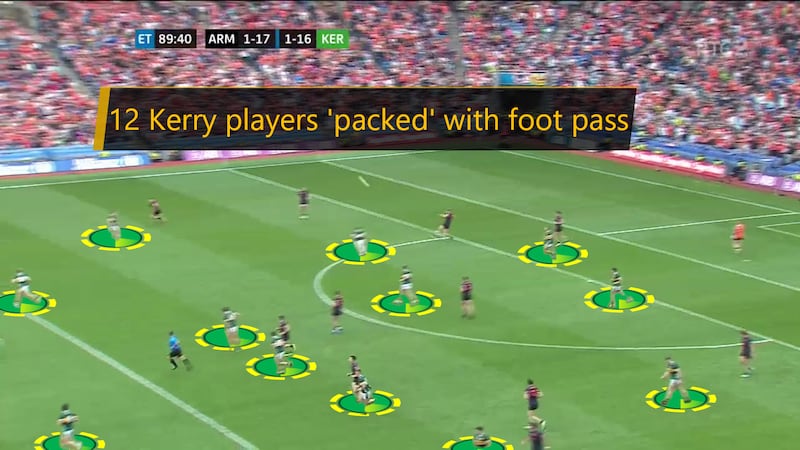
Control: Kerry v Armagh
It won’t get the praise it deserves but during the final quarter in normal time, Armagh tried to operate two different attacking plays as they looked to control the game and get a clutch score. Armagh attempted their spine set up in the 57th minute as they got their attacking players ahead of the ball in a narrow spine between the goalposts and attempted to manufacture a mark just outside the D in the shooting zone. It nearly worked perfectly, the kick was executed well but Andrew Murrin was tightly marked and the ball was spoiled.
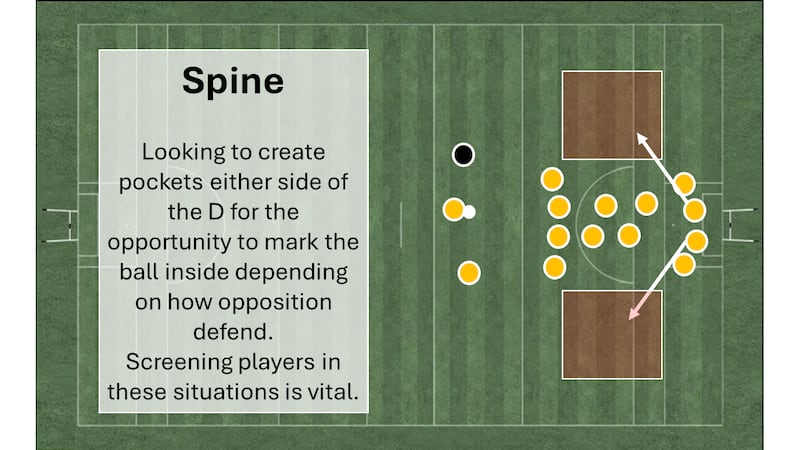
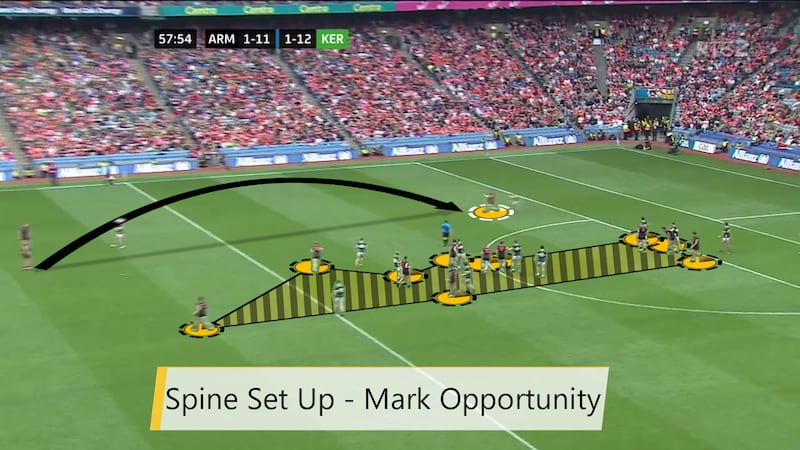
Again, as the game entered the four minutes of injury time, Armagh were in possession and on RTÉ co-commentary Eamonn Fitzmaurice acknowledged that Armagh were setting up in a specific attacking structure. They were controlling the ball on the outside arc and got all of their attackers high inside the 20m line, or completely wide hugging the touchline. It cleared out the entire area between the 20m line and 45m line centrally. This was done with the intention of creating a mismatch on the outside for an Armagh ball carrier to break the line, or for an inside dart out to the D area to win a mark in a good shooting position.
Armagh held the ball for just under two minutes and looked to make this play but the cohesiveness wasn’t there, while there was also that reluctance to make the play too early and allow Kerry another attack, as they tried to wind the clock down.

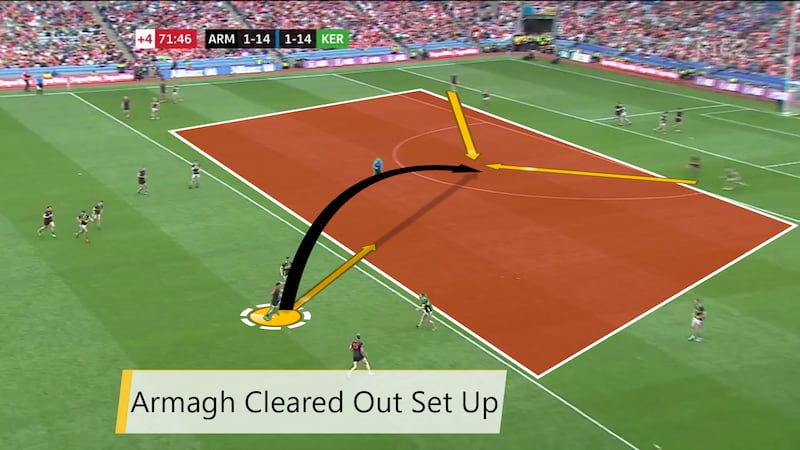
The creativity and ingenuity in attack may not get the credit it deserves as neither resulted in a score, but it was there. In a weekend where the Galway team spoke about John O’Mahony and his forward thinking on the game, Gaelic football is currently showing lots of innovation. How much (if any) of this is down to Kieran Donaghy and his coaching? And his basketball influence? Or is it the addition of Conleith Gilligan, or are the players driving adjustments?
Both set ups are great to see, as this column was critical of Armagh in their use of marks in the Ulster Final against Donegal. In the second half of the Ulster final they were looking to take marks in the wrong positions in the closing stages with low percentage shots, but they were certainly trying to get the marks against Kerry in better shooting positions, even if they didn’t materialise.
Control with the ball in hand is what the attacking team are looking for when involved in a one-score game. Kerry wanted to get David Clifford on the ball for that final shot at goal in normal time. Clifford himself orchestrated an overload under the Hogan stand to get himself isolated 1v1 on the Cusack stand side. Armagh never fully allowed the 1v1 to materialise fully and helped out Barry McCambridge throughout.
The Fossa man got in possession of the ball twice in the play but neither was remotely a shooting opportunity. As the game was in the balance in the 89th minute – just before O’Neill’s kick to unleash Turbitt to stretch the lead to two – Clifford was hovering around the 45m line looking for a recycled ball, but this time he was given zero breathing room by McCambridge, as the Kerry effort dropped short. Kerry needed others to take on the leadership mantle.
Kerry’s over reliance in the scoring stakes on the likes of David Clifford and Sean O’Shea is contrasted by Donegal’s spread of scorers. Ultimately in the clutch moments it could be argued that Kerry’s over-reliance on so few was as detrimental as Donegal’s lack of reliance on any individual.
All year Jim McGuiness has trusted scores to come from different sources on different days, but when the pressure was highest, Donegal were forced to kick under more pressure and from further out. Galway closed down Oisín Gallen individually and with Paddy McBrearty on the sideline, each shot weighed a little heavier.
Galway also made a concerted effort to protect the area on the outskirts of the D, where Donegal scored eight times from in the first half. Donegal as a result fell from a shot efficiency in the first half of 10/14 (71%) to 5/14 (36%). This is down to the coordinated Galway defending again, pressuring the shooter and filling the key shooting zone. Galway controlled the Donegal shooting zones. Donegal stuck to their principles though and, much like after 2011, the attacking adjustments to their game next year will be interesting to see.
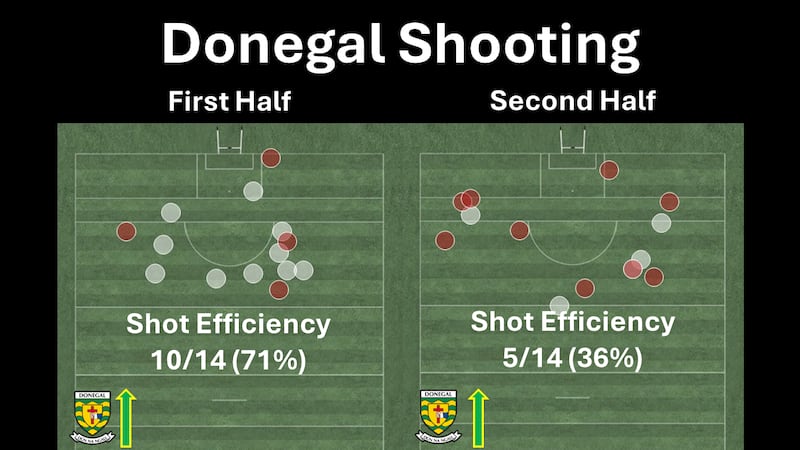
A second meeting of the year for Armagh and Galway is to come in the final. That day in Markievicz Park, the game finished a draw and, much like the two games at the weekend, it is fine margins which will decide the final and not one specific facet of the game.
Paul O’Brien is a performance analyst with The Performance Process (twitter.com/NoPlanBGAA).















